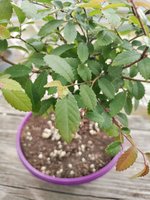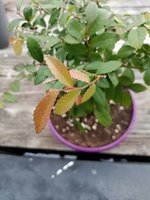This was sold as an Ulmus Parvifolia and then came with a sticker that said "Zelkova Parvifolia". I have read what I can find about their differences but still feel unsure. Most important is it to know if it's a Zelkova or an Ulmus, as I will be keeping it outdoors in Norway through the winter if possible.
I think this is a Zelkova Serrata of some kind, but regular Zelkova has bigger leaves than this one. It has single-toothed and slightly rough leaves, new leaves come with orange/pink colours and turn green with time.
Thank you in advance for any and all insights you might have!
I think this is a Zelkova Serrata of some kind, but regular Zelkova has bigger leaves than this one. It has single-toothed and slightly rough leaves, new leaves come with orange/pink colours and turn green with time.
Thank you in advance for any and all insights you might have!




